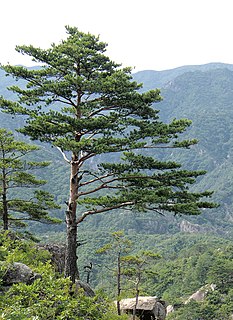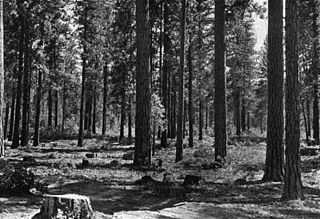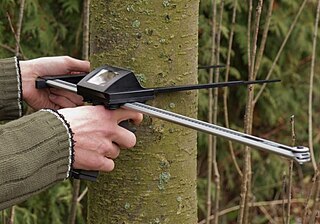
Wood is a porous and fibrous structural tissue found in the stems and roots of trees and other woody plants. It is an organic material, a natural composite of cellulose fibers that are strong in tension and embedded in a matrix of lignin that resists compression. Wood is sometimes defined as only the secondary xylem in the stems of trees, or it is defined more broadly to include the same type of tissue elsewhere such as in the roots of trees or shrubs. In a living tree it performs a support function, enabling woody plants to grow large or to stand up by themselves. It also conveys water and nutrients between the leaves, other growing tissues, and the roots. Wood may also refer to other plant materials with comparable properties, and to material engineered from wood, or wood chips or fiber.

A pine is any conifer in the genus Pinus of the family Pinaceae. Pinus is the sole genus in the subfamily Pinoideae. The Plant List compiled by the Royal Botanic Gardens, Kew and Missouri Botanical Garden accepts 126 species names of pines as current, together with 35 unresolved species and many more synonyms.

Agathis australis, commonly known by its Māori name kauri, is a coniferous tree of Araucariaceae in the genus Agathis, found north of 38°S in the northern districts of New Zealand's North Island.
In archaeology, timber circles are circular arrangements of wooden posts interpreted as being either complexes of freestanding totem poles or as the supports for large circular buildings.

Chlorocardium rodiei (greenheart) is a species of flowering plant in the family Lauraceae. It is one of two species in the genus Chlorocardium. It is native to Guyana and Suriname in South America. Other common names include cogwood, demerara greenheart, ispingo moena, sipiri, bebeeru and bibiru.
Giant retinal ganglion cells are photosensitive ganglion cells with large dendritic trees discovered in the human and macaque retina by Dacey et al. (2005).
The log scaler is an occupation in the timber industry. The Log Scaler measures the cut trees to determine the scale (volume) and quality (grade) of the wood to be used for manufacturing. When logs are sold, in order to determine the basis for a sale price in a standard way, the logs are "scaled" which means they are measured, identified as to species, and deductions for defects assigned to produce a net volume of merchantable wood. There are several different scales or rules that are used to determine the volume of wood. Scribner Decimal C rule is based on diagrams of circles that show the amount of boards that will be utilized from diameters of logs. Cubic rule, often called Metric in Canada, determines the cubic volume of the log material. The logs are recorded as gross scale and net scale. This occupation is usually performed by a third party organization qualified to "scale" government timber. Since internal defects are determined by external indications, scaling is not an exact science and is subject to interpretation of log scaling rules. The log scaler is subject to random "check scales" in which another scaler rescales exactly the same logs and the results are compared. The log scaler must be within + or - 1% of the gross scale and + or - 2% of the net scale to keep their certification to scale. The scale is used for payment, quality control and inventory purposes.

Selection cutting, also known as selective cutting, is the silvicultural practice of harvesting trees in a way that moves a forest stand towards an uneven-aged or all-aged condition, or 'structure'. Using stocking models derived from the study of old growth forests, '"Selection cutting"', also known as 'selection system', or 'selection silviculture', manages the establishment, continued growth and final harvest of multiple age classes of trees within a stand. A closely related approach to forest management is Continuous Cover Forestry (CCF), which makes use of selection systems to achieve a permanently irregular stand structure.

Diameter at breast height, or DBH, is a standard method of expressing the diameter of the trunk or bole of a standing tree. DBH is one of the most common dendrometric measurements.
Fly rod building is the art of constructing a fly fishing rod to match the performance desires of the individual angler.
The following outline is provided as an overview of and guide to forestry:

Pericopsis elata is a species of flowering plant in the family Fabaceae and is known by the common names African teak, afromosia, afrormosia, kokrodua and assamela.

A diameter tape (D-tape) is a measuring tape used to estimate the diameter of a cylinder object, typically the stem of a tree or pipe. A diameter tape has either metric or imperial measurements reduced by the value of π. This means the tape measures the diameter of the object. It is assumed that the cylinder object is a perfect circle. The diameter tape provides an approximation of diameter; most commonly used in dendrometry.
A Volume table is a chart to aid in the estimation of standing timber volume. These tables are based on volume equations and use correlations between certain aspects of a tree to estimate the volume to a degree of certainty. The diameter at breast height (DBH) and the merchantable height are used to determine the total volume. Difficulties occur when estimating the form class of the tree in question. The Mesavage and Girard form classes used to classify the trees to decide which volume table should be used. These volume tables are also based on different log rules such a Scribner, Doyle, and International ¼” scale. In order to be effective, the proper form class must be selected as well as accurate DBH and height measurements.
Forest inventory is the systematic collection of data and forest information for assessment or analysis. An estimate of the value and possible uses of timber is an important part of the broader information required to sustain ecosystems. When taking forest inventory the following are important things to measure and note: species, diameter at breast height (DBH), height, site quality, age, and defects. From the data collected one can calculate the number of trees per acre, the basal area, the volume of trees in an area, and the value of the timber. Inventories can be done for other reasons than just calculating the value. A forest can be cruised to visually assess timber and determine potential fire hazards and the risk of fire. The results of this type of inventory can be used in preventive actions and also awareness. Wildlife surveys can be undertaken in conjunction with timber inventory to determine the number and type of wildlife within a forest. The aim of the statistical forest inventory is to provide comprehensive information about the state and dynamics of forests for strategic and management planning. Merely looking at the forest for assessment is called taxation.
The wedge prism is a prism with a shallow angle between its input and output surfaces. This angle is usually 3 degrees or less. Refraction at the surfaces causes the prism to deflect light by a fixed angle. When viewing a scene through such a prism, objects will appear to be offset by an amount that varies with their distance from the prism.
The Biltmore stick is a tool used by foresters to estimate tree trunk diameter at breast height. The tool very often includes a hypsometer scale to estimate height as well. It looks much like an everyday yardstick. A Biltmore stick is considered to be only marginally accurate. Some foresters use the tool regularly, however, many prefer to use more accurate tools such as a diameter tape to measure diameter at breast height (DBH) and a clinometer to measure height. On the other end of the spectrum, some foresters consider the use of a Biltmore stick to be no more accurate than their own visual estimates, and make it practice for their surveys to be largely completed in this manner.
In forestry, quadratic mean diameter or QMD is a measure of central tendency which is considered more appropriate than arithmetic mean for characterizing the group of trees which have been measured. For n trees, QMD is calculated using the quadratic mean formula:

Pseudotsuga menziesii var. menziesii, also known as coast Douglas-fir, Pacific Douglas-fir, Oregon pine, or Douglas spruce, is an evergreen conifer native to western North America from west-central British Columbia, Canada southward to central California, United States. In Oregon and Washington its range is continuous from the Cascades crest west to the Pacific Coast Ranges and Pacific Ocean. In California, it is found in the Klamath and California Coast Ranges as far south as the Santa Lucia Mountains with a small stand as far south as the Purisima Hills, Santa Barbara County. In the Sierra Nevada it ranges as far south as the Yosemite region. It occurs from near sea level along the coast to 1,800 metres (5,900 ft) in the California Mountains. Further inland, coast Douglas-fir is replaced by Rocky Mountain or interior Douglas-fir. Interior Douglas-fir intergrades with coast Douglas-fir in the Cascades of northern Washington and southern British Columbia.

The Cahokia Woodhenge was a series of large timber circles located roughly 850 metres (2,790 ft) to the west of Monks Mound at the Mississippian culture Cahokia archaeological site near Collinsville, Illinois. They are thought to have been constructed between 900 and 1100 CE; with each one being larger and having more posts than its predecessor. The site was discovered as part of salvage archaeology in the early 1960s interstate highway construction boom and one of the circles was reconstructed in the 1980s. The circle has been used to investigate archaeoastronomy at Cahokia. Annual equinox and solstice sunrise observation events are held at the site.











